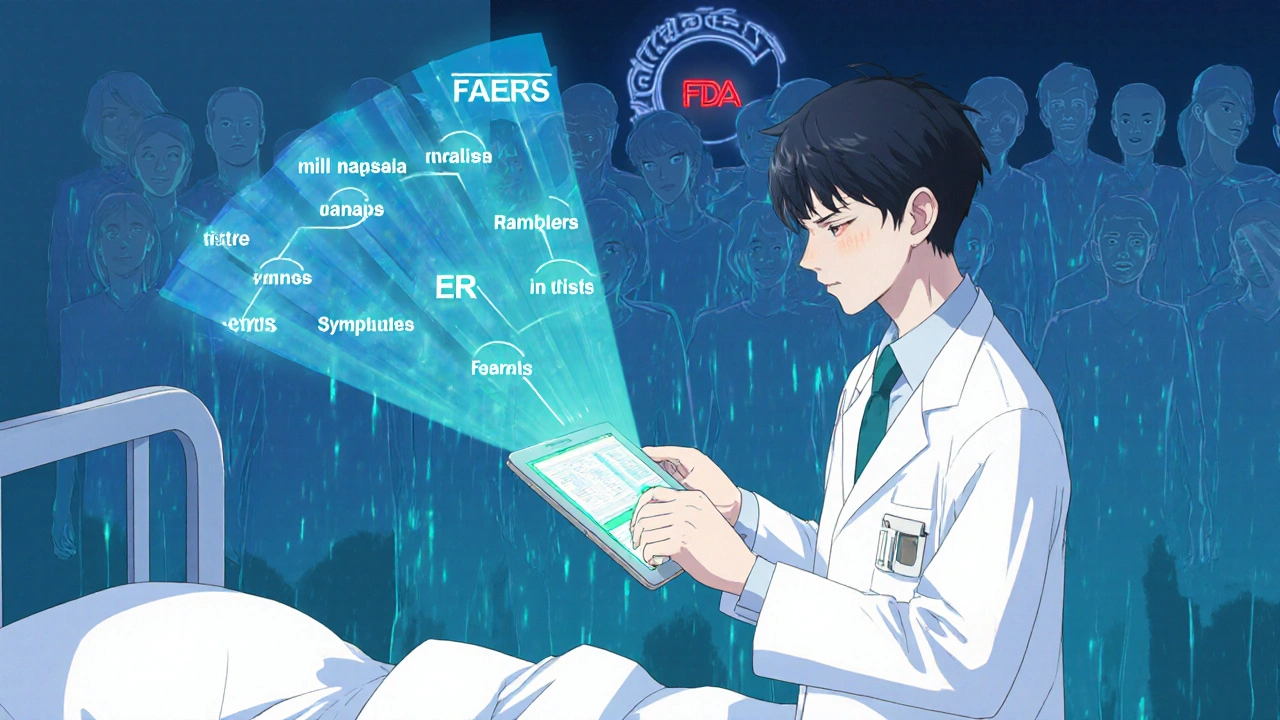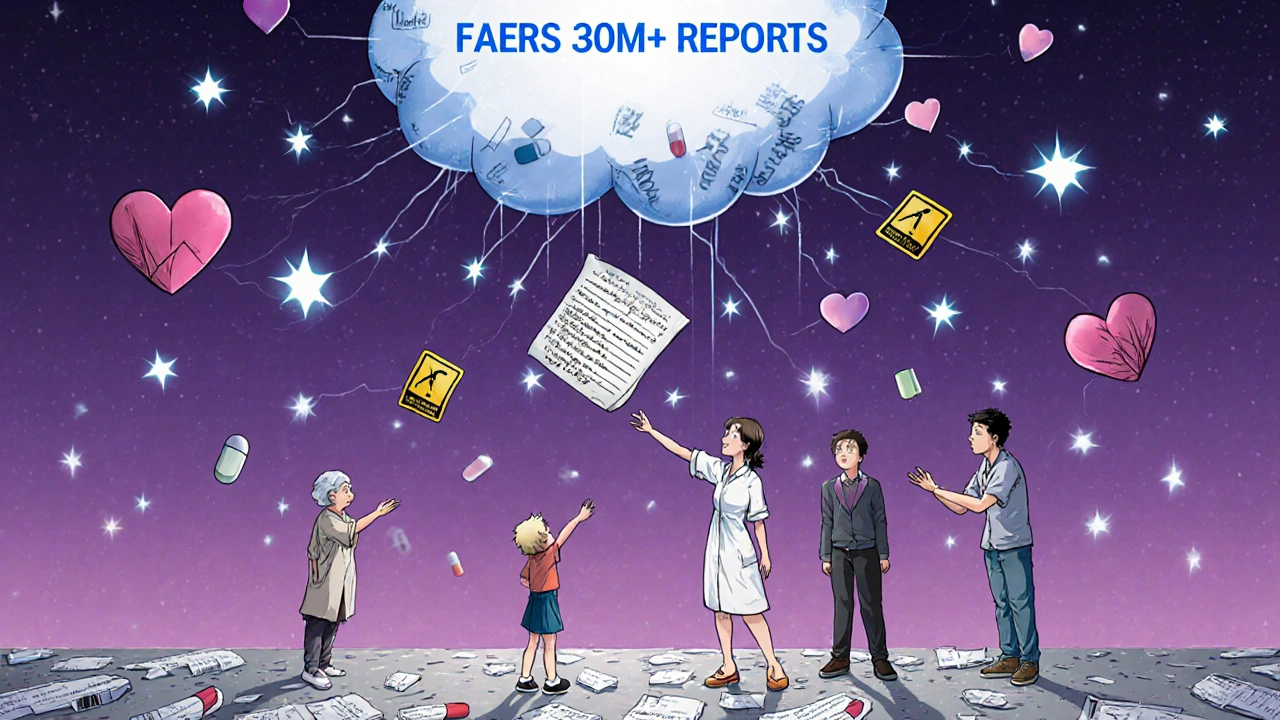Every year, millions of people take prescription drugs without issue. But for some, a medication causes something unexpected - a rash that won’t go away, dizziness that turns into fainting, or worse. When that happens, reporting it to the FDA isn’t just a good idea - it’s a critical part of keeping drugs safe for everyone. The FDA doesn’t know about every bad reaction until someone speaks up. And you don’t have to be a doctor to do it.
What Counts as an Adverse Event?
An adverse event is any harmful or unwanted reaction that happens after taking a medication. It doesn’t have to be proven to be caused by the drug. If you suspect a link, report it. That includes:- Side effects not listed on the label
- Severe reactions like anaphylaxis, liver damage, or heart rhythm problems
- Overdoses, even if accidental
- Withdrawal symptoms after stopping a drug
- Medications that didn’t work when they should have
The FDA’s system, called FAERS (FDA Adverse Event Reporting System), collects over 2 million reports each year. It’s not a tool to get immediate help - it’s a safety net for the public. These reports help the FDA spot patterns. One person’s experience might be the clue that leads to a warning, a label change, or even a drug being pulled from the market.
Who Can Report?
Anyone can report. You don’t need permission. Here’s how it breaks down:- Patients and caregivers: You’re the most important source. Your real-world experience matters more than you think.
- Healthcare providers: Doctors, nurses, pharmacists - they’re required to report serious events for certain drugs, like vaccines.
- Pharmaceutical companies: They must report every serious, unexpected reaction within 15 days. Their reports make up about half of all submissions.
Even if your doctor doesn’t file a report, you can. And if you’re a provider, don’t assume someone else will do it. Your report could save a life.
How to Report as a Patient or Family Member
The easiest way is through the FDA’s MedWatch program. Here’s how to do it right:- Collect the basics: Write down the name of the medication (brand and generic), dosage, how long you took it, and when the problem started. If you have the pill bottle or packaging, take a photo.
- Describe the event clearly: Don’t say “I felt bad.” Say: “After taking 50mg of lisinopril daily for 3 weeks, I developed severe swelling in my lips and throat on March 12. I went to the ER. I was given epinephrine and discharged the same day.” Include dates, symptoms, and outcomes.
- Include medical details: If you had lab tests, imaging, or hospital visits, note them. Reports with lab results are 68% more likely to trigger a safety review.
- Go to www.fda.gov/medwatch: Click “Report a Problem.” You’ll find Form 3500 - the online version.
- Fill it out: The form asks for your contact info (optional), patient details (age, gender), drug info, and a full description. You can upload photos of labels or prescriptions.
- Submit: You’ll get a confirmation number. Save it. If the system times out (yes, it happens), you can return within 3 days using that number to finish.
There’s a 3,000-character limit for the event description. If you need more space, attach a separate document. Don’t leave out details because you think it’s “too much.” The more specific, the better.
How Healthcare Professionals Report
If you’re a clinician, your report carries more weight. Here’s how to make it count:- Use your medical records to back up your description. Include diagnosis codes, lab values, and treatment responses.
- Use the same MedWatch form - but don’t skip the clinical context. A report that says “patient had nausea” is less useful than one that says “patient developed grade 3 transaminitis 7 days after starting metformin, resolved after discontinuation.”
- Reports from providers are 73% more likely to lead to further investigation, according to FDA internal data from 2022.
- If it’s a serious event (life-threatening, hospitalization, disability, congenital anomaly, or death), you’re legally required to report it for certain drugs, including vaccines under the National Childhood Vaccine Injury Act.
Don’t wait for a patient to ask you to report. If something unusual happens, file it. You’re helping the system catch problems before they spread.

What Happens After You Submit?
The FDA doesn’t call you back to say “thanks.” But your report goes into FAERS - a database with over 30 million entries. Trained analysts use software to look for patterns. If 10 people report the same rare reaction to the same drug, it triggers a deeper review.Here’s what can happen next:
- The drug’s label gets updated with a new warning.
- The FDA issues a public safety alert.
- A new study is launched to investigate the link.
- In rare cases, the drug is withdrawn.
It takes time. The average lag between report and initial review is 217 days, according to the Government Accountability Office. That’s why your report matters - it’s a piece of a puzzle that can’t be solved without you.
Common Mistakes and How to Avoid Them
Most reports fail because of simple oversights:- Too vague: “I felt weird after taking the pill.” → Fix: “I had chest tightness and shortness of breath 2 hours after taking 20mg of atorvastatin on May 5.”
- Missing dates: Always include when you started the drug, when the event happened, and when it ended.
- Not including other meds: Did you take anything else? Supplements? Alcohol? These can interact.
- Assuming it’s “expected”: Even if it’s listed as a side effect, if it was worse than expected or happened unexpectedly, report it.
- Waiting too long: The sooner you report, the better the data. Don’t wait months.
Also, don’t think your report won’t matter because “someone else already reported it.” The FDA needs multiple reports to see a pattern. One report is a whisper. Ten are a shout.
Why This System Isn’t Perfect - But It’s Vital
The FDA’s system has flaws. Experts estimate only 1% to 10% of adverse events are ever reported. Many people don’t know how. Others think it’s pointless. But here’s the truth: the system has caught major dangers.In 2018, FAERS data helped identify a link between fluoroquinolone antibiotics and aortic aneurysms. That led to a “Black Box” warning - the strongest safety alert the FDA can issue. In 2020, reports of rare blood clots after the Johnson & Johnson vaccine led to a temporary pause and updated guidance.
Without these reports, those risks might have gone unnoticed for years. The FDA doesn’t test drugs on millions of people before approval. Real-world use is where hidden dangers show up. Your report fills that gap.
And yes, the system is slow. The FDA has only one safety reviewer for every 18,000 reports. But that doesn’t mean your report is lost. It’s stored, analyzed, and cross-referenced. It might be the one that tips the scale.

What’s Changing in 2025?
The FDA is upgrading. In 2023, they launched FAERS Public Dashboard 2.0 - a free tool anyone can use to search reports by drug, reaction, or date. In 2024, they’re rolling out AI tools that scan reports for patterns using natural language processing. And by 2025, they plan to connect with electronic health records to automatically pull in data from hospitals and clinics.That could increase reporting rates by 300%. But even with automation, human reports will still be essential. AI can’t replace the story behind the symptom - the context, the timing, the details only a patient or provider remembers.
What to Do If You’re Not Sure
If you’re unsure whether to report:- Ask your doctor or pharmacist: “Is this something I should report to the FDA?”
- Check the drug’s label online at drugs.com or the FDA’s website. If the reaction isn’t listed, report it.
- If it was serious - ER visit, hospitalization, permanent injury - report it anyway.
You don’t need to be certain. You just need to be honest. The FDA’s job is to investigate. Yours is to inform.
Final Thought: Your Report Could Save a Life
You took a pill to feel better. But for someone else, that same pill might be dangerous. By reporting an adverse event, you’re not just speaking for yourself - you’re helping protect strangers you’ll never meet. It’s simple, it’s fast, and it’s one of the most powerful things you can do as a patient.Don’t wait for the next person to get hurt. Report today. The system doesn’t work without you.
Do I need to be a doctor to report an adverse event to the FDA?
No. Anyone can report - patients, family members, caregivers, or even bystanders. The FDA encourages reports from the public because real-world experiences often reveal risks that clinical trials miss. You don’t need medical training to notice a reaction.
What if I don’t know the exact name of the medication?
If you don’t know the exact name, provide as much detail as possible: the pill’s color, shape, imprint code (letters/numbers on the pill), or a photo of the packaging. The FDA can often identify the drug from these clues. You can also check the National Library of Medicine’s Pill Identifier tool online to help match the pill.
Will I get a response after submitting a report?
You won’t get a personal reply unless the FDA needs more information. But if your report contains enough detail - especially lab results or clear timelines - a safety reviewer may contact you or your provider for follow-up. Most reports are used for aggregate analysis, not individual follow-up.
Is it too late to report an event that happened months ago?
It’s never too late. The FDA accepts reports for events that happened years ago. While timely reports are more useful, older reports still add valuable data to the system. If you remember the details, report it anyway.
Can I report an adverse event for an over-the-counter (OTC) drug or supplement?
Yes. The FDA accepts reports for all medications, including OTC drugs like ibuprofen or acetaminophen, and dietary supplements like fish oil or herbal products. Even if a product isn’t FDA-approved, if it’s sold in the U.S. and caused harm, it should be reported.
Are my personal details kept private?
Yes. The FDA protects personal information in FAERS. Your name, address, and contact details are not made public. When reports are shared with researchers or published in databases, all identifying information is removed. The system is designed to protect your privacy while gathering critical safety data.
What if I report and nothing happens? Is it worth it?
Yes. One report rarely leads to immediate action. But if 10, 50, or 100 people report the same reaction, the FDA can detect a pattern. Many drug safety warnings came from dozens of quiet reports that added up. Your report might be the one that finally triggers a review - even if it takes months or years.
Can I report an adverse event for a drug I took years ago?
Yes. The FDA’s FAERS database includes reports dating back to 1968. If you experienced a reaction years ago and still remember the details, submit it. Historical data helps researchers understand long-term risks and patterns over time.

Patrick Marsh
November 24, 2025 AT 00:00Just reported my wife’s anaphylaxis to lisinopril. Took 5 minutes. No doctor needed. Do it.
Julie Pulvino
November 25, 2025 AT 12:22This is the kind of post that makes me believe people still care about public health. Thank you for breaking it down so clearly. I’ve been telling my elderly neighbors to report weird side effects-now I can just send them this link. 💙
Jessica Correa
November 25, 2025 AT 16:55I didn’t know you could report OTC meds too I just reported my son’s rash from ibuprofen last week thought it was just allergies but now I’m glad I did
luke young
November 27, 2025 AT 06:01My pharmacist told me to report my dizziness after starting metoprolol. I thought it was just me being anxious but turns out it’s a known issue that wasn’t on the label yet. Glad I did it. Small act big impact.
David Cunningham
November 27, 2025 AT 21:07Used to think these reports were pointless until my cousin’s liver failure got flagged after 3 others reported the same supplement. Now I report everything. Even if it’s just a weird headache. You never know.
Danny Nicholls
November 28, 2025 AT 22:48Just submitted my report for that weird tingling after taking fish oil 🤔 thought it was just nerves but then I read the label and realized it wasn’t listed. FDA pls don’t ignore me 😅 I’m not a doctor but I’m not dumb either. Also I took a pic of the bottle-hope that helps!
Daniel Jean-Baptiste
November 29, 2025 AT 22:03My sister reported a reaction to a generic blood pressure med and two months later the FDA added a new warning. It’s not glamorous but it’s how safety actually works. We all think it’s someone else’s job but really it’s ours
Nikhil Chaurasia
November 30, 2025 AT 13:50As someone from India I’ve seen people avoid reporting because they think the system won’t care. But this post changed my mind. I just reported my father’s reaction to a statin-no English fluency needed, just clear facts. The FDA doesn’t need your degree, just your truth.
manish chaturvedi
December 2, 2025 AT 04:26While the system is imperfect, the fact remains: without patient reports, we’d be flying blind. In my medical practice in Delhi, I’ve seen drugs withdrawn in the US years after they caused harm here because no one reported. Reporting isn’t bureaucracy-it’s solidarity. I now require all my patients to sign a small form acknowledging they’ve been informed about FAERS. It’s not optional. It’s civic duty.
Robin Johnson
December 3, 2025 AT 05:03Don’t wait for the FDA to ask you. Don’t wait for your doctor to do it. If something feels wrong after taking a pill, write it down. Submit it. You’re not being dramatic-you’re being responsible. This system survives because of people like you who do the quiet, unglamorous work.
Rahul Kanakarajan
December 3, 2025 AT 05:46Why are we even doing this? The FDA is a broken system. They get millions of reports and do nothing. My cousin’s kid died from a vaccine reaction and they buried it in a database. This is performative safety. You think your report matters? It doesn’t. It’s just noise.
New Yorkers
December 3, 2025 AT 17:03It’s not about reporting-it’s about the illusion of control. We think our little form will change the world, but the pharmaceutical machine is too big, too greedy, too insulated. We’re just rearranging deck chairs on the Titanic while the FDA sips coffee and waits for the next billion-dollar lawsuit. Your report? It’s a poem written in the dark. Beautiful. Pointless.
Holly Schumacher
December 4, 2025 AT 12:59Correction: The GAO report cited says the average lag is 217 days for *initial review*, not full analysis. Also, the 73% statistic for provider reports is from a 2021 internal FDA memo-not peer-reviewed. And you missed that FAERS data is not publicly verifiable-no raw data access, only aggregated summaries. If you’re going to cite stats, cite them right. Otherwise, you’re just spreading misinformation wrapped in good intentions.